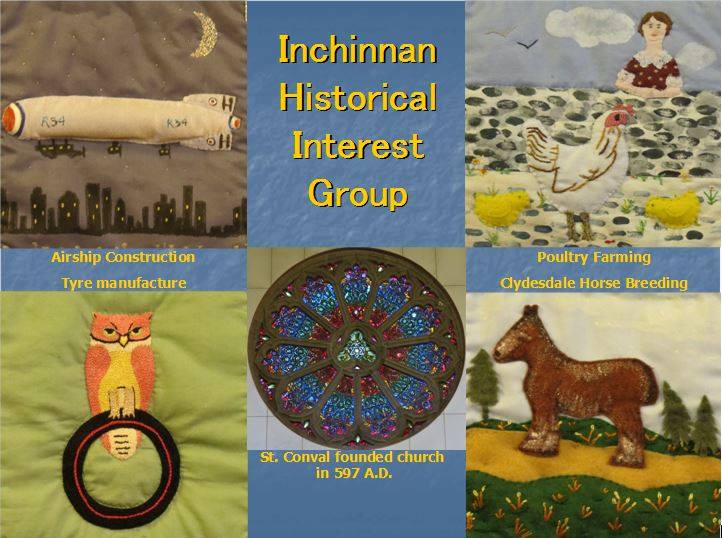PRESS RELEASE – Ancient stone re-discovered at Inchinnan
,
Bill McCallum (Inchinnan Historical Interest Group)
The latest digital photography techniques applied to the ancient burial stones at Inchinnan Parish Church have revealed that one of the stones, thought to be medieval in date, was originally carved much earlier and probably commemorated an important person within the Kingdom of Strathclyde.
As a part of the ‘St Conval to All Hallows’ community archaeology project, Clara Molina Sanchez (Spectrum Heritage) has been using a technique called Reflectance Transformation Imaging (RTI) on the burial stones to bring out the worn detail which is no longer visible to the naked eye. Megan Kasten (a PhD student from the University of Glasgow) has been studying the many carved stones at Govan Old church and wanted to compare these with the stones at Inchinnan. Earlier this month she examined the 3D models from Inchinnan closely and to her surprise noticed that one stone had a cross on the top third of the stone and faint panels of interlace.
The stones came originally from the site of All Hallows, Inchinnan, a small hill next to the Black Cart Water. The church there was demolished in the 1960s to make way for Glasgow Airport. The church site was traditionally the burial place of St Conval, possibly an early Christian saint who may have been buried at Inchinnan in the 6th century AD. This discovery adds to the existing three large carved stones decorated with crosses, carved animals and interlace that are characteristic of a group of sculpture that is typically referred to as the ‘Govan School’ of carving. These stones date to the 9th to 12th century when All Hallows, along with Govan and Dumbarton Rock, were places of burial for the elite of the Kingdom of Strathclyde. A medieval church was later built on the site and was the property of the Knights Templar and later the knights of St John. A new church was built on the site in 1828 and this was significantly enlarged in 1904 by Lord Blythswood.
All the stones have decorations and/or inscriptions, which are generally not visible to the naked eye. To make these carvings visible, two different digital documentation techniques were used. Firstly, photogrammetry was used to accurately capture the shape of the stones. In this case, the colour of the biological growth makes it harder to see the details on the surface, but, by ‘deactivating’ it, the different carvings of swords, crosses and inscriptions can now be seen.
The second technique, RTI (Reflectance Transformation Imaging) is a multi-image technique that provides very detailed information on the surface of a material. RTI files allow the user to explore the surface of the material virtually with different lighting conditions. In this case, a Virtual RTI was created from the photogrammetric models. And to do that, a digital dome made up of 93 lights was placed over the 3D models, thus creating an image for every light. These images were processed, which in turn produced an RTI file for each one of the stones. This made it possible to obtain information about the stones’ decorations that can also complement the photogrammetry itself. The combination of both techniques has been proven to be a very valuable tool to unveil details of the surface invisible otherwise to the naked eye.
Megan Kasten revealed her discovery at the final round-up meeting at Inchinnan on Saturday the 18th November. She said “this new addition is really exciting! We have few historical records for this time period, so each new discovery increases our understanding of the connections between important early medieval sites in the local area, like Inchinnan and Govan”
Dr Sally Foster, Lecturer in Heritage and Conservation at the University of Stirling and Chair of the National Committee on Carved Stones in Scotland says, ‘The discovery of a previously unrecognised example of the ‘Govan School’ of early medieval sculpture is a wonderful example of the untapped potential of Scotland’s carved stone resource. It shows the power of interdisciplinary research, including the latest scientific techniques, to shed light on the long, complex and unexpected biographies of carved stones. It’s exactly the sort of research project that the National Committee on Carved Stones in Scotland’s ‘Listen to the Stones’ online booklet seeks to promote as part of Future Thinking on Carved Stones in Scotland : http://www.scottishheritagehub.com/ftcss_listen
Dr Heather James (Calluna Archaeology) says ‘It has been great seeing the community and professionals working together to discover so much more about our fascinating heritage through this project’.
This re-discovery comes at the end of a season of archaeological work in 2017 at All Hallows developed and led by the Inchinnan Historical Interest Group and Dr Heather James of Calluna Archaeology. This project has involved geophysics, excavation, historical research, model making, film making, graveyard recording and has enabled several local schools and numerous volunteers to get a taste of archaeology.
The project is funded by the Heritage Lottery Fund, Historic Environment Scotland, Robert Barr Charitable Trust, Hugh Fraser Foundation, AMW Charitable Trust, Foundation Scotland – Dickon Trust Fund, Peter Coats Trust, Peter Brough Bequest Fund and the Glasgow Airport Authority Flightpath fund.
Contact details:
Bill McCallum Inchinnan Historical Interest Group (bill.mccallum@idnet.co.uk)
(Web page – https://myinchinnan.org.uk/)
Facebook: InchinnanHistoricalInterestGroup
Twitter: @InchinnanHIG
Megan Kasten (m.kasten.1@research.gla.ac.uk)
Clara Molina Sanchez, Spectrum Heritage (clara@spectrumheritage.com)
Heather James, Calluna Archaeology (calluna.archaeology@gmail.com)
Sally Foster (s.m.foster@stir.ac.uk)
